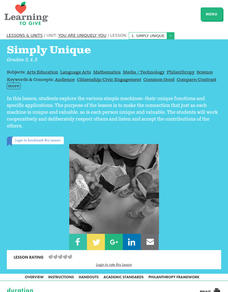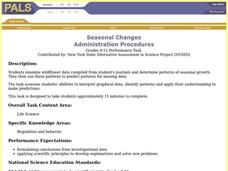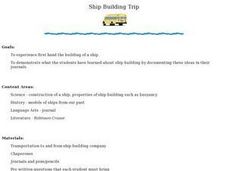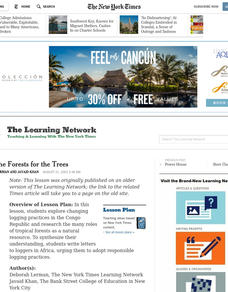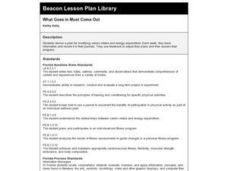Curated OER
Are You a Frog?
Students listen to the book "Ask Me If I'm a Frog, and compare their anatomy and habits to the anatomy and habits of a frog to identify with the characteristics unique to frogs. They respond to teacher-generated questions by writing...
National First Ladies' Library
Leeches and Spiders and Toads, Oh, My! The Emergence of Modern Medicine
Students explore the basic ideas and beliefs about medicine in the 18th and 19th centuries. They write a news account to be published in a "medical journal" developed by the class. Each "article" in the journal should be dated...
Curated OER
Strong Vibes
Learners consider how the tension of a rubber band relates to the stress build-up in earthquakes. They conduct research and write fictional television coverage about a Pacific Northwest town that is hit by an earthquake.
Curated OER
Simply Unique
Students identify, compare and contrast simple machines and their functions. They work together in groups to complete experiments using the simple machines. They write in their journals to reflect on the lesson plan.
Curated OER
How Manduca See
Third graders investigate how manduca sees and they discuss what they think the manduca might be thinking. They write a story about what an insect sees and does from the insect's perspective.
Curated OER
A Thoreau Look at Our Environment
Sixth graders write journal entries o school site at least once during each season, including sketched and written observations of present environment. They can use sample topographical maps and student's own maps. Students can use...
Curated OER
Tadpoles to Frogs!
Third graders observe the tadpoles/frogs and draw a picture in their journals every week to monitor its growth with 100% accuracy. They observe tadpoles/frogs and record at least two changes or the observations the tadpole undergoes...
Curated OER
Air Pollution: What Can You Do?
Third graders read the book "Air Pollution" by Gary Lopez. They reflect on what causes air pollution and write about it in their journals, learning new vocabulary and using it each day.
Curated OER
Chameleons
Students read "The Mixed-Up Chameleon" by Eric Carle. They discuss the chameleon's color changes and their ability to catch flies. They read a fact sheet. They view a live chameleon in a natural environment. They write down observations...
Curated OER
What It Is, What It Isn't
Third graders classify and sort different types of beans to be introduced to the classification system in science. As a class, they identify the characteristics of living and non-living organisms and make a chart in their journal to ...
Curated OER
The Window
Students read a story entitled, "The Window," and discover how some cultures are rejected by others. Students write a letter expressing feelings of rejection and keep a journal of significant events in the story. Using a graphic...
Curated OER
Seasonal Changes
Pupils examine wildflower data compiled from their student journals from the school year. They determine patterns of seasonal growth then use these patterns to predict patterns for missing data.
Curated OER
Animals of Rainforest and Temperate Forest
Students research an animal from each type of forest, and compare/contrast them on a concept map. They write a letter from one animal to the other, using information from their research.
Curated OER
A Worm World
Young scholars maintain a compost bin and build a worm observatory. They design experiments relating to worms and record observations in a worm journal.
Curated OER
Plants
Students plant bean seeds and draw pictures of the plants as they grow. They create their own garden, plant the seeds, and keep a journal of their growth.
Curated OER
Singing in the H2O
Students compose new lyrics to the tune of a popular song in order to teach and explain a challenging science concept being studied in class.
Curated OER
Ship Building Trip
Students travel to a ship building plant to see how they are built. They enter into discussion and writing about the task of the building. This lesson is multiple intelligence in design and valuable because of the real life exposure.
Curated OER
To Sleep, Perchance to Dream
Students examine their thoughts on the origin and meaning of dreams on a personal basis. They compare and contrast different models of the nature of dreams. They maintain a dream journal over a specific period of time.
Curated OER
Seeing the Forests for the Trees
Young scholars explore changing logging practices in the Congo Republic and research the many roles of tropical forests as a natural resource. To synthesize their understanding, students write letters to loggers in Africa, urging them to...
Curated OER
Growing Tomatoes
Second graders investigate the growth of tomatoes. They plant grape tomatoes and observe them. They write in a journal and take digital pictures of their tomato plants. They create bar graphs to tally the progress of their plants and...
Curated OER
Crazy Critters
Eighth graders visit a local park to collect insects. They record the habitats, identify the insect and write a report including the kingdom, phylum, class, and order.
Curated OER
Got Biodiversity?
Students examine the concept of biodiversity. Using the internet, they complete small activities in which they work together. Using the information they collected, they create a class book, make murals and write in their journals.
Curated OER
Dream Machines
Students explore the modern applications of robots and create one of the five parts of a robot that could solve a hypothetical public works problem. They study about the use of robots for laying fiber-optics cable in New Mexico by...
Curated OER
What Goes in Must Come Out
Students monitor their calorie intake and energy expenditure. They keep track of daily data in a journal and assess and adjust their diets as appropriate.



